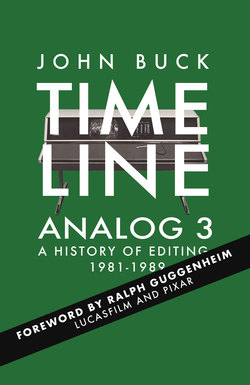Читать книгу Timeline Analog 3 - John Buck - Страница 2
На сайте Литреса книга снята с продажи.
Foreword by Ralph Guggenheim
Оглавление“You can recognize the pioneers by the arrows in their backs.”
- Popular saying.
With this volume, we are midstream in the saga of editing techniques and technology. As you work your way through this carefully researched history (in itself, a timeline), it can be easy to lose sight of the achievements of the people who inhabit these volumes. Hindsight dims the brilliance of their work. What seems intuitive to us today wasn’t so clear or obvious when these ideas first sprang from their imaginations.
They navigated a sea of conflicting issues: What the available technology could deliver; What new technology was on the horizon; What customers could afford. And those “arrows” in their backs? Would customers be willing to adapt and change or would they sabotage new ideas in an attempt to hang onto the status quo? The “random walk” across decades of products and development in these pages is, in fact, the tale of visionaries who sought a solution to a specific need. They wanted to reduce the effort required to take a story from idea to screen, and unlock creative opportunities for the storytellers, the directors and editors.
In 1979, George Lucas was frustrated that the films he wanted to make were hobbled by antiquated tools that limited his vision. Forty of us were recruited to establish a research division at Lucasfilm (the team doubled by 1986). Our mission – to bring advanced digital techniques to film production.
We were not the only hub of innovation attacking these problems. There were many others – some collaborators, some competitors. We were all invested in achieving that watershed moment. When we started, hardly any films were made with any form of computer assistance. Today, no film is made without digital technology.
The potential for ongoing development and advancement stretches endlessly to a horizon beyond our view. Each technical innovation frees artists and creators to imagine new stories and more immersive experiences. There’s a lot to mine in these books. They offer us the opportunity to learn from this past in order to cut a path to newer and better techniques in the future.
Ralph Guggenheim Project Lead, Lucasfilm’s EditDroid (1980-1985)
